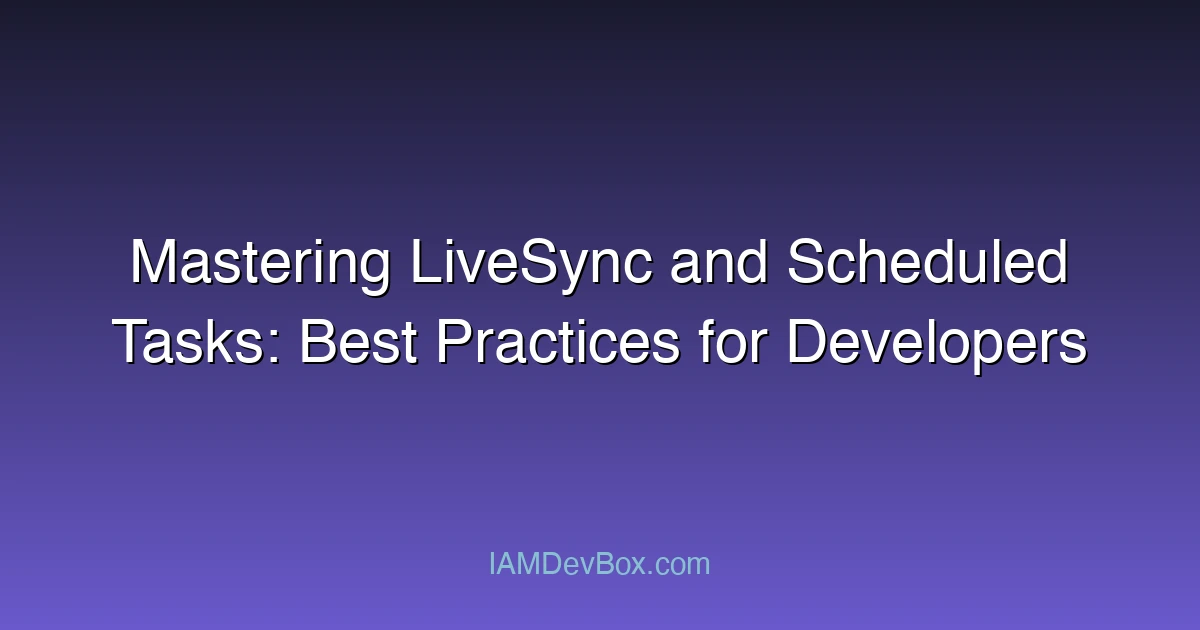In the modern digital landscape, real-time data synchronization (LiveSync) and scheduled task execution are critical components of many applications. Whether you’re building a collaborative workspace, a real-time analytics dashboard, or a backend system that requires periodic maintenance, mastering these techniques can significantly enhance the functionality and user experience of your application. This blog post explores practical strategies for implementing LiveSync and executing scheduled tasks efficiently.
Understanding LiveSync: Real-Time Data Synchronization
LiveSync refers to the process of maintaining real-time data consistency between two or more systems. This is particularly important in applications where users expect immediate updates, such as chat applications, collaborative editing tools, or IoT devices. Achieving LiveSync requires a robust infrastructure and careful planning.
Key Components of LiveSync
- Data Sources: Identify the origin of your data. This could be a database, an API, or a third-party service.
- Synchronization Mechanism: Choose the right method to push or pull data. Common approaches include:
- WebSocket: Establishes a bi-directional communication channel for real-time updates.
- HTTP Long Polling: Sends periodic requests to the server to check for updates.
- Server-Sent Events (SSE): Allows servers to push updates to clients over a single HTTP connection.
- Conflict Resolution: Implement logic to handle conflicting updates, especially in distributed systems.
Example Use Case: Real-Time Chat Application
Consider a chat application where messages need to be displayed instantly. A WebSocket-based LiveSync mechanism ensures that messages are pushed to all connected clients as soon as they are sent. Below is a simplified flowchart of this process:
Executing Scheduled Tasks: Best Practices
Scheduled tasks are automated processes that run at predefined intervals. These tasks can range from database backups to sending email notifications. Implementing them efficiently is crucial for maintaining application performance and reliability.
Choosing the Right Tool
- Cron Jobs: A popular choice for Linux-based systems, Cron allows you to schedule tasks using a simple syntax.
- Task Queues: Frameworks like Celery (Python) or Sidekiq (Ruby) enable you to distribute tasks across multiple workers, improving scalability.
- Cloud Services: Platforms like AWS Lambda or Google Cloud Functions allow you to run scheduled tasks without managing servers.
Example: Scheduling a Daily Backup
Here’s an example of a cron job that schedules a daily database backup at 2:00 AM:
0 2 * * * /usr/local/bin/backup_script.sh
This script runs the backup_script.sh file every day at 2:00 AM. You can customize the script to handle specific backup logic, such as compressing files or sending notifications.
Monitoring and Maintenance
-
Logging: Ensure that your tasks generate detailed logs for debugging and auditing purposes.
-
Error Handling: Implement retries for failed tasks and notify administrators of critical issues.
-
Scalability: Use distributed task queues to handle high volumes of scheduled tasks without performance degradation.
Combining LiveSync and Scheduled Tasks
In many applications, LiveSync and scheduled tasks go hand in hand. For example, a real-time inventory management system might use LiveSync to update stock levels as items are sold, while scheduled tasks handle end-of-day reporting and inventory restocking.
Real-World Case Study: E-commerce Platform
An e-commerce platform might use the following architecture:
In this setup:
- LiveSync ensures that inventory levels are updated in real time.
- Scheduled tasks handle end-of-day processes, such as generating sales reports and sending notifications to store managers.
Conclusion
Implementing LiveSync and scheduled tasks requires careful planning, robust infrastructure, and attention to detail. By choosing the right tools and following best practices, you can build applications that deliver real-time updates and maintain consistent performance. Whether you’re working on a small project or a large-scale system, these techniques are key for creating seamless and reliable user experiences.
Extended Questions for Reflection
- How can you optimize LiveSync for high-traffic applications?
- What are the potential challenges of running scheduled tasks in a distributed system?
- How can you ensure data consistency during LiveSync in a multi-region deployment?
By addressing these questions, you can further refine your approach and build more resilient systems. Happy coding!
